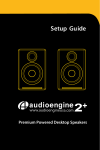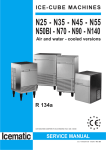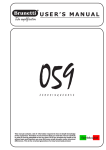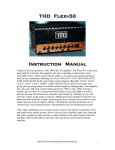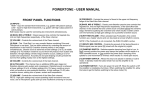Download Blue Sierra Amplifier
Transcript
Service Notes Tech Specs Blue Sierra Amp Power usage Pre Amp Tubes Reverb Tube* Tubes 50 Watt 100 Watt 250 Watts 350 Watts 3 each ECC83 1 each 12AT7 * Reverb is an option that may not exist in your amp. Power Tubes** Power Tube Option** 2EA EL34 4EA EL34 2EA 6L6 4EA 6L6 * *Power Tubes should be purchased as matched sets. Use only tubes in pairs or quads that are factory-matched. Failure to use matched tubes can lead to tube failure and amplifier damage or abnormal operation. Main Fuses 100V 50Hz/60Hz 120V 60Hz 230V 50Hz Filament Fuses B+ Fuses Weight Head 1x12 Combo 2x12 Combo Dimensions Head 2A 250V Type 3AG 4A 250V Type 3AG 2A 250V Type 3AG 4A 250V Type 3AG 1.5A 250V Type 3AG 2.5A 250V Type 3AG 2 each 10A 250V Type 3AG 2 each 500mA 440V Type 3AG 34 lbs (15.5kg) 40 lbs (18.2kg) 54 lbs (24.5kg) N/A 62 lbs (28.2kg) 68 lbs (31kg) 22.5in X 11in X 9.75in 22.5in X 11in X 9.75in 1x12 Combo 22.5in X 20in X 9.75in N/A 2x12 Combo 26.5in X 21in X 9.75in 26.5in X 21in X 9.75in Tubes are consumables as they have a given usable lifespan. They are part of the heart of the tone, so keeping correctly operating tubes is essential. Tubes can fail catastrophically or gradually and it’s good to know what to look for if they start to go bad. Periodically inspect them and look to see if anything inside the tube is glowing cherry red other than the normal orange glow of the filament. This would indicate a situation where the tube is conducting more current than it is capable of handling and most likely about to fail. Two other conditions to observe are 1) filaments not glowing or 2) a miniature fireworks display inside the tube. Any of the above conditions indicate serious problems with the tube and should be taken care of immediately. Tubes quite often are the cause of spurious noise in the amp. Microphonic tubes will squeal or rattle with the vibrations of the cabinet. If suspected, tap each tube lightly with a pencil with the amp powered up—the suspect tube will let you know. Note that there is a normal metallic clinking when doing this, but a microphonic tube will be quite loud. Instructions for Qualified Service Technician: To install the tubes, check that the power cord is not plugged in, then remove the wooden back panel with a screwdriver and notice the tube sockets. Note that the cooling fan may need to be unplugged from the chassis. Looking from the back, install the Power tubes (EL34, 6L6, etc.) in the left sockets. In each case, align the center pin guide correctly with the socket, making sure that the pin guide key fits with the corresponding slot in the socket. The ECC83 preamp tubes can then be placed in the smaller 9-pin sockets to the right of the power tubes. Please refer to the tube chart inside the amplifier for proper tube locations. Be aware of the pin alignment with these, as there is only one way they can fit. We utilize tube sockets that allow relative ease of tube installation, but never force tubes into the sockets if there becomes a problem. Also, never torque the tubes, only gently rock them from side to side during insertion or removal. After preamp tube installation, place the cylindrical spring tension preamp tube covers over the tubes. Ensure the cooling fan is plugged back into the jack on the chassis. Failing to do so can create a safety hazard. Replacing preamp tubes will not require any adjustment, but the power tubes will need rebiasing to assure proper operation. After power tube replacement, initially inspect the tubes often to assure there are no “cherry red” components within the tube. Tubes today can have a wide variety of tolerances and a re-bias is highly recommended with new ones. Fuses There are 5 fuses installed in the amplifier. Only 1 of these, the main input fuse, is accessible and replaceable by the user. There are 4 fuses internally for added safety. 2 of these fuses are high voltage fuses and 2 fuses are for the lower filament voltages. In all cases, labels indicate the type and rating of the fuse. Replacement fuses MUST BE THE SAME TYPE AND RATING. If they are not you can permanently damage your amplifier. Please contact your local PRS dealer or the PRS accessories web site for information on ordering replacement fuses. Instructions for Qualified Service Technician: Replacement of internal fuses requires removal of the back panel and removal of the chassis. First, ensure the power cord is not plugged in, then remove the back panel with a screwdriver. Turn the amplifier upside down and place on padded and safety-certified work surface. Loosen the 4 bolts holding the chassis to the top of the cabinet. The reverb pan may need to be removed before removing the chassis. Ensure the reverb cords are unplugged, and remove the hardware holding the reverb pan in place. Check that all components are cool so that burns do not occur. Then, by holding onto the transformers, lift the front of the amp so the front control is out of the cabinet and carefully pull the chassis out. NOTE! Capacitors may retain an electric charge and can be dangerous even when the unit is off, unplugged and has not been played for an extended period of time. USE CAUTION!!!! Locate the fuse holders, remove them, and check for continuity. Blown fuses can indicate a failure condition and should be treated as though a problem exists. Check the label for the proper type and rating. After all fuses have been replaced and the amp is tested as acceptable and safe, reinstall the chassis by working in reverse. Be sure to replace the reverb pan and hardware, then plug the reverb cords back into place. Before installing the back panel, ensure the cooling fan cord is plugged into the proper jack. Blue Sierra Guitar Amplifier User’s Manual Using your PRS Amplifier A few years ago, I was at the Dallas Vintage Guitar Show and my band was scheduled to perform a few times. A friend said, “Hey. You need an amp to play through, and I have a friend who makes great amps.” He took me to the booth of a Texas amp builder, Doug Sewell. I loved the way his amps sounded, and after barely saying hello, Doug and I were inside rewiring the amp I was going to play through. Since that day, Doug and I have spent years rewiring and listening to every single possible variation to finalize the circuits. Our goal was to have highly usable and musical amplifiers. I am not an amp collector. I am an amplifier user who keeps the amps I am presently playing through. That said, after Doug and I got several of the prototypes finalized, I sold some of my old coveted live and studio amps because ours sounded considerably better. The next step was to take the prototypes to musicians who are known for their amplifier tone as well as their playing. What’s interesting is that when I spoke to these artists about trying the amps, they all said the same thing. “Sure I’ll use them, if I love them.” In a real way, amplifiers are musical instruments. They are the devices that “amplify” the sound of the player’s hands, the guitar and possibly the pedal board. They must share many qualities. They must work - they have to have a beautiful balance of bass, midrange, and treble; the highs should be sweet - not harsh; they should be easy to operate and be highly musical. In addition, amps should clean up really well when you turn your guitar down. The final quality that Doug and I looked for are amps that sound good no matter where the knobs are. It is a rare quality that we insisted on. I hope this hand-crafted amplifier gives you years of enjoyment, musical results, and pride in ownership. I appreciate your confidence. Rear Panel Controls IMPORTANT: Before using your amplifier, refer to the IMPORTANT SAFETY INSTRUCTIONS insert supplied with the product. Powering Up: 1. Make sure your speaker cabinet is connected to the correct speaker output impedance jack with a high quality speaker cable. Do not use guitar cords. 2. Make sure the power cord is connected to the correct grounded outlet. 3. Make sure there is at least 6 inches of clearance behind the amplifier to allow for proper cooling. Never place the amplifier against a wall or other equipment, and keep it clear of other heat sources, such as other amplifiers or stoves. Make sure there are no flammable items such as curtains, behind the amp. Do not drape items over the amps that can prevent proper cooling. Do not set drinks or other liquids on top of the amp that can spill into the amp. 4. To increase the life of the tubes, set the “Standby” switch to the STANDBY position before powering on. Turn the POWER switch on and let the amplifier warm up for 2 minutes before setting the standby switch to “ON.” If this is the first time you are turning on the amp, check to see if all of the tubes are glowing. 5. Plug in the guitar cable, turn the volume knob down and turn the standby switch on. Wait a few seconds for the bias to settle. Bring the volume up and play some tunes. VOLUME TREBLE MIDDLE ADJUSTMENTS ONLY TO BE MADE BY QUALIFIED TECHNICIAN TO AVOID DAMAGE, NEVER OPERATE WITHOUT PROPER SPEAKER LOAD 250 W FUSE FUSE - 2A 250V Type 3AG Replace fuse only with same type and rating. CAUTION - RISK OF ELECTRIC SHOCK - DO NOT OPEN. No user serviceable parts inside ATTENTION - RISQUE DE CHOC ÉLECTIQUE - NE PAS OUVRIR. No pièce réparable par l'utilisateur WARNING - TO REDUCE THE RISK OF FIRE OR ELECTRIC SHOCK, DO NOT EXPOSE THIS EQUIPMENT TO RAIN OR MOISTURE AVIS - POUR RÉDUIRE LE RISQUE D'INCENDIE OU DE CHOC ÉLECTRIQUE, NE PAS EXPOSER CET EQUIPEMENT A LA PLUIE OU L'HUMIDIT Fuse: Blown fuses may indicate that the amplifier needs servicing. Use only the type and rating specified on the back of the amplifier. See the section on Service Notes for proper fuse servicing and replacement. Power Switch: This cuts off all power to the amplifier. No filament current or tube voltages are supplied. Standby Switch: When this switch is in STANDBY, the amplifier tubes are effectively turned off, but are still being warmed by the filaments if the POWER is on. Keep this switch set to STANDBY when powering on the amplifier for at least 2 minutes to allow the tubes to warm up. This also helps extend the life of the tubes. When set to ON, the tubes are turned on and the amplifier can be used. Always check this switch if the amp is ON but no sound is being heard. Bias Jacks: Biasing and Tube Replacement should be performed only by a qualified technician. Blue Sierra Amplifier Front Panel Controls INPUT Input Power 120V~60HZ BASS MASTER Input: 1/4” standard guitar cord. Volume: The volume is one of the most important controls on the amp. Depending on the output of your pickups, you can find your sweet spot at various locations on the sweep. There will be a point in which actual volume stops increasing and the tone becomes thicker and more compressed. Each guitar will react differently, and exploring this control should be a source of great enjoyment. Be aware that settings beyond 2 o’clock will increase background noise. Reverb: The reverb on the Blue Sierra is designed to enhance and thicken the tone without covering it up too much. This is important to reduce unwanted modulation with heavy distortion settings. Treble: The treble control is very sensitive in both clean and dirty settings. Like all five knobs, there are no numbers to encourage you to set the amp with your ears. Speaker Jacks: Get into the habit of checking these first. The jacks include a connection for 4, 8 and 16 ohm loads. There is an extension (EXT) jack with the 4 ohm and 8 ohm connection to connect two 8 ohm loads if you wish. This scenario could most commonly be the use of an 8 ohm extension speaker along with the internal speaker—connect each to the 4 ohm jacks since their combination produces a 4 ohm load. Do not connect an 8 ohm load in the 8 ohm jack along with a 4 ohm or 16 ohm load in those jacks. This procedure halves the reflected impedance of each and will not allow ideal operating conditions. If you are using more than one speaker, they must be the same impedance. For example, use two 4-ohm speakers, or two 8-ohm speakers. Never use 2 different speaker impedances - You should not mix and match. The maximum number of speakers you can safely connect is 2. Always ensure that the speaker impedance matches the correct speaker jack, since this amp is designed to be played “wide open”. Mismatching impedances from a lower tap to a higher speaker impedance stresses the amp more than going into a lower impedance mismatch, and can cause arcs on the tube sockets, failure of power tubes, or even failure of the output transformer. Confirm that the speaker cabinet you are using matches to the correct speaker jack on the back of the amp. For the 4 OHM and 8 OHM speaker jacks, a second cabinet may be plugged into the “EXT” (Extension) cabinet. Note: The total speaker impedance must be determined before connecting to the speaker jacks. Middle: Using less mids creates crisper, more “hollow” sounding tones. Clean settings using less mids can sound very American, working well with single coil tones for clean blues, surf, and country. Adding mids tranforms the tone to a warm, fatter jazz-approved tone. Distortion with more mids can sound very 60s and 70s, less mids ventures into 80s metal tones. Bass: The low end control allows you to tailor the amount of bass appropriate for the speakers and cabinet you are playing through. Inherently bassy cabinets can sound very boomy with high bass settings on the amp. Open back cabinets generally can accept higher bass settings without this. Master: Controls the overall volume of the amplifier. The master volume is a post phase-inverter style and allows you to drive the preamp into distortion while maintaining low volumes. Turn it all the way up (with the volume down) for maximum clean settings, and reverse that setting for distortion. For higher gain settings with high volume, the master can be backed off slightly to reduce inherent background noise. Bright Switch: This switch uses a capacitor to bypass highs around the volume potentiometer. It is only effective when the volume is set low and increasingly fades out as the volume is increased. This switch adds sparkle to your clean settings. Jewel Power Indicator: If the jewel is lighted, the amp is on. This does not indicate the standby setting of the amp. Note: An amplifier may be plugged in and “on”, but a malfunctioning or burnt-out indicator will not show the amp is on. Check the power cord and Power Switch if the jewel light is not on. If these are connected correctly, then check the main fuse. If the main fuse burns out, check for proper speaker connections. If the fuses continue to blow, the amplifier may need servicing. Sample Settings: For American-flavored clean tones, a good starting point would be the treble at 2 o’clock, middle at 10, and bass at noon with the bright switch on. For jazz settings, set treble at 9 o’clock, middle at 2, and bass at 10 o’clock. Set the master all the way up, then bring the volume up to taste. For metal type distortion, set the bass at 3 o’clock, middle at 9, and treble at 3. For old-school rock, bass at 11 o’clock, middle at 2, and treble at noon. Set the volume to between 2 and 3 o’clock, then bring the master volume up to taste. © 2009 PRS Guitars All rights reserved. “Paul Reed Smith,” “PRS,” the PRS logo, the PRS Paul Reed Smith logo, the Paul Reed Smith signature, the bird inlays, the headstock bird, the PRS headstock shape, the PRS body shape, the PRS “scoop” design, “Singlecut”, “Mira” and the “SE” are all registered trademarks of Paul Reed Smith Guitars “Custom 24,” “Modern Eagle,” “SE Custom,” “SC 245,” “SC 250,” “Starla”, “Tonare”, “Sewell”, “ Blue Sierra”, and “Angelus” are all trademarks of Paul Reed Smith Guitars. The Birds, New Birds, are copyrighted by PRS Guitars.









